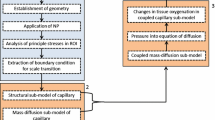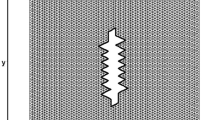Abstract
The residual limb of transtibial amputation (TTA) prosthetic users is threatened daily by pressure ulcers (PU) and deep tissue injury (DTI) caused mainly by sustained mechanical strains and stresses. Several risk factors dominate the extent of internal tissue loads in the residuum. In this study, we developed a set of three-dimensional finite element (FE) models that were variants of a patient-specific FE model, built from magnetic resonance imaging scans. The set of FE modes was utilized to assess the impact of the following risk factors on the strain/stress distribution in the muscle flap: (i) the tibial length, (ii) the tibial bevelment, (iii) a fibular osteophyte, (iv) the mechanical properties of the muscle, and (v) scarring in different locations and depths. A total of 12 nonlinear FE model configurations, representing variations in these factors, were built and solved. We present herein calculations of compression, tension and shear strains and stresses, von Mises stresses, and strain energy density averaged in critical locations in the muscle flap as well as volumes of concentration of elevated stresses in these areas. Our results overall show higher stresses accumulating in the bone proximity rather than in outlying soft tissues. The longer bone configurations spread the loads toward the external surfaces of the muscle flap. When shortening the truncated bones from 11.2 to 9.2 cm, the von Mises stresses at the distal edges of the bones were relieved considerably (by up to 80%), which indicates a predicted decreased risk for DTI. Decreasing the tibial bevelment mildly, from 52.3° to 37.7° caused propagation of internal stresses from the bone proximity toward the more superficial soft tissues of the residuum, thereby also theoretically reducing the risk for DTI. An osteophyte at the distal fibular end increased the strain and stress distributions directly under the fibula but had little effect (<1%) on stresses at other sites, e.g., under the tibia. Elevation of muscle stiffness (instantaneous shear modulus increase from 8.5 to 16.2 kPa), simulating variation between patients, and muscle flap contraction or spasm, showed the most substantial effect by an acute rise of the von Mises stresses at the bone proximity. The mean von Mises stresses at the bone proximity were approximately twofold higher in the contracted/spastic muscle when compared to the flaccid muscle. Locating a surgical scar in different sites and depths of the residuum had the least influence on the overall loading of the muscle flap (where stresses changed by <7%). Pending further validation by epidemiological PU and DTI risk factor studies, the conclusions of this study can be incorporated as guidelines for TTA surgeons, physical therapists, prosthetists, and the TTA patients themselves to minimize the onset of PU and DTI in this population. Additionally, the present analyses can be used to guide or focus epidemiological research of PU and DTI risk factors in the TTA population.












Similar content being viewed by others
Abbreviations
- 3D:
-
Three dimensional
- BPL:
-
Bone proximity layer
- DTI:
-
Deep tissue injury
- FE:
-
Finite element
- FPL:
-
Fat proximity layer
- MRI:
-
Magnetic resonance imaging
- PU:
-
Pressure ulcer
- SED:
-
Strain energy density
- TTA:
-
Transtibial amputation
- VOI:
-
Volume of interest
References
Agam, L., and A. Gefen. Pressure ulcers and deep tissue injury: a bioengineering perspective. J. Wound Care 16:336–342, 2007.
Ankrom, M. A., R. G. Bennett, S. Sprigle, D. Langemo, J. M. Black, D. R. Berlowitz, and C. H. Lyder. Pressure-related deep tissue injury under intact skin and the current pressure ulcer staging systems. Adv. Skin Wound Care 18:35–42, 2005.
Avar, B. B., N. Hudyma, and M. Karakouzian. Porosity dependence of the elastic modulus of lithophysae-rich tuff: numerical and experimental investigations. Int. J. Rock Mech. Min. Sci. 40:919–928, 2003.
Baum, B. S., B. L. Schnall, J. E. Tis, and J. S. Lipton. Correlation of residual limb length and gait parameters in amputees. Injury 39:728–733, 2008.
Burgess, E. Amputations. Surg. Clin. North. Am. 63:749–770, 1983.
Dou, P., X. Jia, S. Suo, R. Wang, and M. Zhang. Pressure distribution at the stump/socket interface in transtibial amputees during walking on stairs, slope and non-flat road. Clin. Biomech. 21:1067–1073, 2006.
Dunn, M. G., F. H. Silver, and D. A. Swann. Mechanical analysis of hypertrophic scar tissue: structural basis for apparent increased rigidity. J. Invest. Dermatol. 84:9–13, 1985.
Ertl, J. Uber amputationsstumpfe. Chirurg 20:218–224, 1949.
Gefen, A. Plantar soft tissue loading under the medial metatarsals in the standing diabetic foot. Med. Eng. Phys. 25:491–499, 2003.
Gefen, A., and E. Haberman. Viscoelastic properties of ovine adipose tissue covering the gluteus muscles. J. Biomech. Eng. 129:924–930, 2007.
Gefen, A., B. Nierop, D. L. Bader, and C. W. Ooomens. Strain-time cell-death threshold for skeletal muscle in a tissue-engineered model system for deep tissue injury. J. Biomech. 41:2003–2012, 2008.
Hendriks, F. M., D. Brokken, J. T. van Eemeren, C. W. Oomens, F. P. Baaijens, and J. B. Horsten. A numerical-experimental method to characterize the non-linear mechanical behaviour of human skin. Skin Res. Technol. 9:274–283, 2003.
Henrot, P., J. Stines, F. Walter, N. Martinet, J. Paysant, and A. Blum. Imaging of the painful lower limb stump. Radiographics 20:S219–S235, 2000.
Hoyt, K., T. Kneezel, B. Castaneda, and K. J. Parker. Quantitative sonoelastography for the in vivo assessment of skeletal muscle viscoelasticity. Phys. Med. Biol. 53:4063–4080, 2008.
Kapp, S. Suspension systems for prostheses. Clin. Orthop. Relat. Res. 361:55–62, 1999.
Kern, U., C. Martin, S. Scheicher, and H. Muller. Effects of botulinum toxin type B on stump pain and involuntary movements of the stump. Am. J. Phys. Med. Rehabil. 83:396–399, 2004.
Lago, N., and X. Navarro. Evaluation of the long-term regenerative potential in an experimental nerve amputee model. J. Peripher. Nerv. Syst. 12:108–120, 2007.
Laurent, A., F. Mistretta, D. Bottigioli, K. Dahel, C. Goujon, J. F. Nicolas, A. Hennino, and P. E. Laurent. Echographic measurement of skin thickness in adults by high frequency ultrasound to assess the appropriate microneedle length for intradermal delivery of vaccines. Vaccine 25:6423–6430, 2007.
Lilja, M., P. Hoffmann, and T. Oberg. Morphological changes during early trans-tibial prosthetic fitting. Prosthet. Orthot. Int. 22:115–122, 1998.
Lilja, M., S. Johansson, and T. Oberg. Relaxed versus activated stump muscles during casting for trans-tibial prostheses. Prosthet. Orthot. Int. 23:13–20, 1999.
Linder-Ganz, E., S. Engleberg, M. Scheinowitz, and A. Gefen. Pressure-time cell death threshold for albino rat skeletal muscles as related to pressure sore biomechanics. J. Biomech. 39:2725–2732, 2006.
Mak, A. F. T., G. H. W. Liu, and S. Y. Lee. Biomechanical assessment of below-knee residual limb tissue. J. Rehabil. Res. Dev. 31:188–198, 1994.
Mattes, S. J., P. E. Martin, and T. D. Royer. Walking symmetry and energy cost in persons with unilateral transtibial amputations: matching prosthetic and intact limb inertial properties. Arch. Phys. Med. Rehabil. 81:561–568, 2000.
Mooney, M. A theory of large elastic deformation. J. Appl. Phys. 11:582–592, 1940.
Nadollek, H., S. Brauer, and R. Isles. Outcomes after trans-tibial amputation: the relationship between quiet stance ability, strength of hip abductor muscles and gait. Physiother. Res. Int. 7:203–214, 2002.
Oomens, C. W., A. Stekelenburg, K. Ceelen, and D. Bader. A damage threshold for skeletal muscle under sustained mechanical loading. In: The Pathomechanics of Tissue Injury and Disease, and the Mechanophysiology of Healing, edited by A. Gefen. Kerala, India: Research Signpost, 2009, pp. 313–326. ISBN: 978-81-308-0314-2.
Palevski, A., I. Glaitch, S. Portnoy, E. Linder-Ganz, and A. Gefen. Stress relaxation of porcine gluteus muscle subjected to sudden transverse deformation as related to pressure sore modeling. J. Biomech. Eng. 128:782–787, 2006.
Peery, J. T., W. R. Ledoux, and G. K. Klute. Residual limb skin temperature in trans-tibial sockets. J. Rehabil. Res. Dev. 42:147–154, 2005.
Pinzur, M. S., J. Beck, R. Himes, and J. Callaci. Distal tibiofibular bone-bridging in transtibial amputation. J. Bone Joint Surg. Am. 90:2682–2687, 2008.
Pinzur, M. S., F. Gottschalk, M. A. Pinto, and D. G. Smith. Controversies in lower extremity amputation. Instr. Course Lect. 57:663–672, 2008.
Pohjolainen, T. A clinical evaluation of stumps in lower limb amputees. Prosthet. Orthot. Int. 15:178–184, 1991.
Portnoy, S., E. Atlas, and A. Gefen. Influence of bony prominence sharpness and underlying tissue stiffness on the susceptibility to pressure-related deep tissue injury: biomechanical computer model studies. L’escarre 36:4–7, 2007 (in French).
Portnoy, S., G. Yarnitzky, Z. Yizhar, A. Kristal, U. Oppenheim, I. Siev-Ner, and A. Gefen. Real-time patient-specific finite element analysis of internal stresses in the soft tissues of a residual limb: a new tool for prosthetic fitting. Ann. Biomed. Eng. 35:120–135, 2007.
Portnoy, S., Z. Yizhar, N. Shabshin, Y. Itzchak, A. Kristal, Y. Dotan-Marom, I. Siev-Ner, and A. Gefen. Internal mechanical conditions in the soft tissues of a residual limb of a trans-tibial amputee. J. Biomech. 41:1897–1909, 2008.
Randon, C., J. Deroose, and F. Vermassen. How to perform a below-knee amputation. Acta Chir. Belg. 103:238–240, 2003.
Rommers, G. M., L. D. Vos, L. Klein, J. W. Groothoff, and W. H. Eisma. A study of technical changes to lower limb prostheses after initial fitting. Prosthet. Orthot. Int. 24:28–38, 2000.
Salawu, A., C. Middleton, A. Gilbertson, K. Kodavali, and V. Neumann. Stump ulcers and continued prosthetic limb use. Prosthet. Orthot. Int. 30:279–285, 2006.
Sanders, J. E., J. R. Fergason, S. G. Zachariah, and A. K. Jacobsen. Interface pressure and shear stress changes with amputee weight loss: case studies from two trans-tibial amputee subjects. Prosthet. Orthot. Int. 26:243–250, 2002.
Sanders, J. E., J. M. Greve, S. B. Mitchell, and S. G. Zachariah. Material properties of commonly-used interface materials and their static coefficients of friction with skin and socks. J. Rehabil. Res. Dev. 35:161–176, 1998.
Sanders, J. E., S. G. Zachariah, A. B. Baker, J. M. Greve, and C. Clinton. Effects of changes in cadence, prosthetic componentry, and time on interface pressures and shear stresses of three trans-tibial amputees. Clin. Biomech. 15:684–694, 2000.
Sanders, J. E., S. G. Zachariah, A. K. Jacobson, and J. R. Fergason. Changes in interface pressures and shear stresses over time on trans-tibial amputee subjects ambulating with prosthetic limbs: comparison of diurnal and six-month differences. J. Biomech. 38:1566–1573, 2005.
Schmalz, T., S. Blumentritt, and R. Jarasch. Energy expenditure and biomechanical characteristics of lower limb amputee gait: the influence of prosthetic alignment and different prosthetic components. Gait Posture 16:255–263, 2002.
Schwartz, S., F. Spencer, A. Galloway, G. Shires, J. Daly, and J. Fischer. Principles of Surgery (7th ed.). New York: McGraw-Hill, pp. 991–999, 1998.
Silver-Thorn, M. B. Prediction and experimental verification of residual limb/prosthetic socket interface pressures for below-knee amputees. PhD Thesis, Department of Biomedical Engineering, Northwestern University, Chicago, IL, USA, 1991.
Smith, K. E., P. K. Commean, and M. W. Vannier. Residual limb shape change: three-dimensional CT scan measurement and depiction in vivo. Radiology 200:843–850, 1996.
Smith, D. G., L. V. McFarland, B. J. Sangeorzan, G. E. Reiber, and J. M. Czeniecki. Postoperative dressing and management strategies for trans-tibial amputations: a critical review. J. Rehabil. Res. Dev. 40:213–224, 2003.
Tonuk, E., and M. B. Silver-Thorn. Nonlinear viscoelastic material property estimation of lower extremity residual limb tissues. J. Biomech. Eng. 126:289–300, 2004.
Vannah, W. M., D. M. Drvaric, J. A. Hastings, J. A. Stand, 3rd, and D. M. Harning. A method of residual limb stiffness distribution measurement. J. Rehabil. Res. Dev. 36:1–7, 1999.
Wilson, A. B. History of amputation surgery and prosthetics. In: Atlas of Limb Prosthetics: Surgery and Prosthetic Principles, edited by J. H. Bowker and J. W. Michael. American Academy of Orthopedic Surgeons. St. Louis, MO: Mosby, 1981.
Zhang, M., and C. Roberts. Comparison of computational analysis with clinical measurement of stresses on below-knee residual limb in a prosthetic socket. Med. Eng. Phys. 22:607–612, 2000.
Acknowledgment
We appreciate the help of Mr. Shmulik Keidar (ADCOM Ltd., Givatayim, Israel) with technical issues related to the ABAQUS analyses.
Author information
Authors and Affiliations
Corresponding author
Rights and permissions
About this article
Cite this article
Portnoy, S., Siev-Ner, I., Yizhar, Z. et al. Surgical and Morphological Factors that Affect Internal Mechanical Loads in Soft Tissues of the Transtibial Residuum. Ann Biomed Eng 37, 2583–2605 (2009). https://doi.org/10.1007/s10439-009-9801-3
Received:
Accepted:
Published:
Issue Date:
DOI: https://doi.org/10.1007/s10439-009-9801-3




